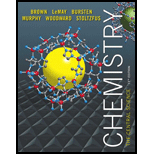
Concept explainers
In the formate ion, HCO2-, the carbon atom is the central atom with the other three atoms attached to it. (a) Draw a Lewis structure for the formate ion. (b) What hybridization is exhibited by the C atom? (c) Are there multiple equivalent resonance structures for the ion? (d) Which of the atoms in the ion have
Learn your wayIncludes step-by-step video

Chapter 9 Solutions
Chemistry: The Central Science (13th Edition)
Additional Science Textbook Solutions
Chemistry: An Introduction to General, Organic, and Biological Chemistry (13th Edition)
General Chemistry: Principles and Modern Applications (11th Edition)
Organic Chemistry (8th Edition)
Chemistry For Changing Times (14th Edition)
Inorganic Chemistry
Introductory Chemistry (5th Edition) (Standalone Book)
- . Assume that the third-period element phosphorus forms a diatomic molecule, P2, in an analogous way as nitrogen does to form N2. (a) Write the electronic configuration for P2. Use [Ne2] to represent the electron configuration for the first two periods. (b) Calculate its bond order. (c) What are its magnetic properties (diamagnetic or paramagnetic)?arrow_forward(a) Methane (CH4) and the perchlorate ion (ClO4- ) are bothdescribed as tetrahedral. What does this indicate about theirbond angles? (b) The NH3 molecule is trigonal pyramidal, while BF3 is trigonal planar. Which of these molecules is flat?arrow_forwardPropylene, C3H6, is a gas that is used to form the importantpolymer called polypropylene. Its Lewis structure is given. (a) What is the total number of valence electrons in the propylenemolecule? (b) How many valence electrons are usedto make σ bonds in the molecule? (c) How many valenceelectrons are used to make π bonds in the molecule? (d) Howmany valence electrons remain in nonbonding pairs in themolecule? (e) What is the hybridization at each carbon atomin the molecule?arrow_forward
- A useful solvent that will dissolve salts as well as organic compounds is the compound acetonitrile, H3CCN. It is present in paint strippers.(a) Write the Lewis structure for acetonitrile, and indicate the direction of the dipole moment in the molecule.(b) Identify the hybrid orbitals used by the carbon atoms in the molecule to form σ bonds.(c) Describe the atomic orbitals that form the π bonds in the molecule. Note that it is not necessary to hybridize the nitrogen atom.arrow_forwardThe lactic acid molecule, CH3CH(OH)COOH, gives sourmilk its unpleasant, sour taste. (a) Draw the Lewis structurefor the molecule, assuming that carbon always forms fourbonds in its stable compounds. (b) How many π and howmany σ bonds are in the molecule? (c) Which CO bond isshortest in the molecule? (d) What is the hybridization ofatomic orbitals around the carbon atom associated withthat short bond? (e) What are the approximate bond anglesaround each carbon atom in the molecule?arrow_forward1. Draw the Lewis structures for each of the following ions or molecules. For each, give (i) the molecular shape, (ii) the electron pair geometry at the central atom, and (iii) the hybridization of the central atom. (a) POF3 (b) XeO₂F3+ (c) BrCl₂ (d) N3 (the central atom is N; two other N's are bonded to it) (e) PF3arrow_forward
- (a) What is the hybridization of chlorine in Clo4 ? (Type your answer using the format sp3 for sp3.) (b) What is the hybridization of bromine in BrF5? (c) What is the hybridization of bromine in BrO2 ?arrow_forwardButadiene, C4H6, is a planar molecule that has the followingcarbon–carbon bond lengths: (a) Predict the bond angles around each of the carbon atoms and sketch the molecule. (b) From left to right, what is the hybridization of each carbon atom in butadiene? (c) The middle C—C bond length in butadiene (1.48 Å) is a little shorter than the average C—C single bond length (1.54 Å). Does this imply that the middle C—C bond in butadiene is weaker or stronger than the average C—C single bond? (d) Based on your answer for part (c), discuss what additional aspects of bonding in butadiene might support the shorter middle C—C bond.arrow_forward7. Nitrogen is the central atom in each of the species given. (a) Draw the Lewis electron-dot structure for each of the species. + NO₂ NO₂ NO₂ (b) List the species in order of increasing bond angle. Justify your answer. (c) For NO₂ and NO₂, give the hybridization of the nitrogen atom in it. (d) Identify the only one of the species that dimerizes and explain what causes it to do so.arrow_forward
- Ammonia, NH3, reacts with incredibly strong bases to producethe amide ion, NH2-. Ammonia can also react with acidsto produce the ammonium ion, NH4+. (a) Which species(amide ion, ammonia, or ammonium ion) has the largestH¬N¬H bond angle? (b) Which species has the smallestH¬N¬H bond angle?arrow_forwardSodium azide is a shock-sensitive compound that releases N2upon physical impact. The compound is used in automobileairbags. The azide ion is N3-. (a) Draw the Lewis structure of theazide ion that minimizes formal charge (it does not form a triangle).Is it linear or bent? (b) State the hybridization of the centralN atom in the azide ion. (c) How many σ bonds and how manyπ bonds does the central nitrogen atom make in the azide ion?arrow_forwardThe sulfate ion can be represented with four S-O bonds or with two S-O and two So=O bonds.(a) Which representation is better from the standpoint of formal charges?(b) What is the shape of the sulfate ion, and what hybrid orbitals of S are postulated for the σ bonding?(c) In view of the answer to part (b), what orbitals of S must be used for the π bonds? What orbitals of O?(d) Draw a diagram to show how one atomic orbital from S and one from O overlap to form a π bond.arrow_forward
 Chemistry: Principles and ReactionsChemistryISBN:9781305079373Author:William L. Masterton, Cecile N. HurleyPublisher:Cengage Learning
Chemistry: Principles and ReactionsChemistryISBN:9781305079373Author:William L. Masterton, Cecile N. HurleyPublisher:Cengage Learning
